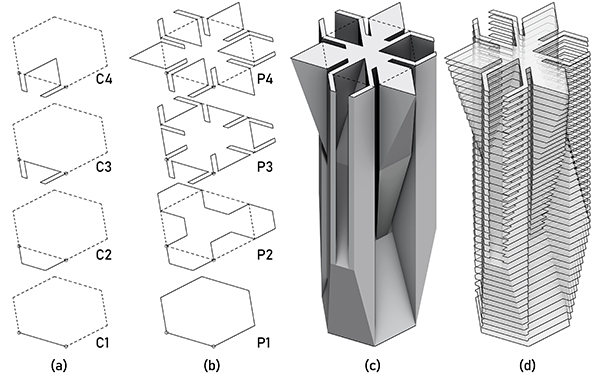Strange Start Startling Stop
by Tuğrul Yazar | November 26, 2022 21:34
 [1]
[1]“Strange Start Startling Stop” was designed by Mary Purdy at the State University of New York[2] in 1985. The composition is based on a hexagonal lattice (above figure). There are four prototiles, marking the four key moments in the shape-shifting process. The first prototile is a regular hexagon, which is also the first tile of the composition. This prototile morphs into a shape that is a composition of four smaller hexagons, creating the second prototile. This morphing process finishes at the 9th tile from the left. The third prototile is then, slowly erected by enlarging a portion of every edge. This morphing process finishes at the 17th tile from the left. The fourth and last prototile is a continuation of the previous one. It expands the parts more and creates snowflake-like spikes to finalize the composition.

This final prototile expands the edges and changes their directions, and the opposing edges merge into single vertices at the end. We re-created these prototiles by four fundamental curves. You can see the fundamental curves and corresponding prototiles shown in above Figures a and b. The designer would probably think of these four prototiles while designing “Strange Start Startling Stop”. One of the important qualities of Parquet Deformations[3] is that they allow partial deformations on single tiles. In the example, the 10th and 18th tiles from the left show this kind of partial deformation. Therefore, we propose this 3D reconstruction methodology to simulate this behavior. After we define prototiles, we match the vertices to create the lofting operation (above Figure c). Then, the 3D prototile is created by utilizing the p31m symmetry operation. This operation repeats several rotation and reflection transformations to create the closed polyhedron.
You can read the rest of this chapter here[4].
- [Image]: https://www.designcoding.net/decoder/wp-content/uploads/2022/11/2022-11-25_strange-scaled.jpg
- State University of New York: http://www.tess-elation.co.uk/parquet-deformations/people
- Parquet Deformations: https://www.designcoding.net/category/research/pattern-deformations/
- here: https://www.degruyter.com/document/doi/10.1515/9783035625189-008/pdf
Source URL: https://www.designcoding.net/strange-start-startling-stop/